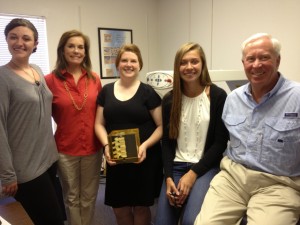
Last summer we conducted the “Teen-to-Teen Bone Health Education Project.” This was a pilot project and first step in providing education as well as gathering valuable research information for future programs. Over a two-week session, the participants met with a total of 23 experts. The girls learned a tremendous amount of information not only about the bone health topic, but also exercise, nutrition, education, art, media, and working as a team. On the last day they presented a summary of what they learned and what they planned to do.
They decided on “5 Essential Facts” that teens should know about bone health:
Bone Mass: 90% of one’s bone mass is formed by age 18. Your preteen and teen years are the critical time to build the strongest bones possible.
Calcium: Daily recommended amount is 1300 mg or 4 glasses of milk or equivalent. If you eat dairy products like yogurt and cheese, it’s easy to eat calcium-rich foods to meet your recommended calcium needs. If you don’t eat dairy products, it is harder but possible with substituting calcium-enriched products like almond milk or orange juice, along with many beans, nuts, and vegetables like kale.
Vitamin D: Daily recommended intake is 600 IU. Although exposure to sun is the main source of vitamin D, you may not be making enough all year round. In the winter months, there may not be enough sun and in the summer months, sunscreen blocks the ability to make vitamin D. Therefore, you get most of your vitamin D from your diet. All milk is fortified with vitamin D. You may want to select a yogurt that is fortified with vitamin D. Otherwise few foods like oily fish, wild salmon and tuna, are rich in vitamin D.
Exercise: Weight-bearing exercise is needed to build strong bones. If you are not on an athletic team and training year-round, you need to be working out about 60 minutes a day. Plan on other outside or in the gym activities to get your daily exercise. Keep moving.
Sodium: Too much sodium is bad; the more sodium in, the more calcium out. Their own diets contained 2 to 3 times the recommended intake of sodium (2300 mg). The high salt content was not from the salt shaker but rather their foods that included choices like pizza and processed luncheon meats.
As a key part of the mission of 4BoneHealth to educate and inspire future generations to achieve optimal bone health, we hope to continue to expand and grow the “Teen-to-Teen Bone Health Education Project” each year with a goal of reaching a critical mass of teens.
To all of you who have made donations to 4BoneHealth, thank you for your help in making a difference.
________________________________________
Diane L. Schneider, MD, MSc
Author, The Complete Book of Bone Health
Medical Editor, 4BoneHealth.org

